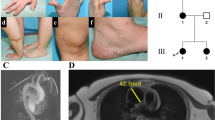Abstract
The S810L mutation within the human mineralocorticoid receptor (MR S810L) induces severe hypertension and switches progesterone from antagonist to agonist. Here we report the crystal structures of the ligand-binding domain of MR S810L in complex with progesterone and deoxycorticosterone, an agonist of both wild-type and mutant MRs. These structures, the first for MR, identify the specific contacts created by Leu810 and clarify the mechanism of activation of MR S810L.
This is a preview of subscription content, access via your institution
Access options
Subscribe to this journal
Receive 12 print issues and online access
$189.00 per year
only $15.75 per issue
Buy this article
- Purchase on Springer Link
- Instant access to full article PDF
Prices may be subject to local taxes which are calculated during checkout


Similar content being viewed by others
References
Bonvalet, J.P. Kidney Int. Suppl. 65, S49–S56 (1998).
Evans, R.M. Science 240, 889–895 (1988).
Nagy, L. & Schwabe, J.W. Trends Biochem. Sci. 29, 317–324 (2004).
Fagart, J. et al. EMBO J. 17, 3317–3325 (1998).
Geller, D.S. et al. Science 289, 119–123 (2000).
Brzozowski, A.M. et al. Nature 389, 753–758 (1997).
Williams, S.P. & Sigler, P.B. Nature 393, 392–396 (1998).
Matias, P.M. et al. J. Biol. Chem. 275, 26164–26171 (2000).
Sack, J.S. et al. Proc. Natl. Acad. Sci. USA 98, 4904–4909 (2001).
Bledsoe, R.K. et al. Cell 110, 93–105 (2002).
Kauppi, B. et al. J. Biol. Chem. 278, 22748–22754 (2003).
Pinon, G.M. et al. Mol. Cell. Endocrinol. 217, 181–188 (2004).
Acknowledgements
We thank J.-L. Ferrer and M. Pirrochi from the FIP-BM30A beamline at the European Synchrotron Radiation Facility for assistance with data collection. We are also grateful to H. Richard-Foy and F. Gouilleux for providing the plasmid pFC31Luc and to S. Jalaguier for the plasmid pGEX-KG. We also thank colleagues for their critical reading of the manuscript. This work was supported by Institut National de la Santé et de la Recherche Médicale (INSERM).
Author information
Authors and Affiliations
Corresponding author
Ethics declarations
Competing interests
The authors declare no competing financial interests.
Supplementary information
Supplementary Fig. 1
Stereo view of electron density of the ligand-binding pocket of MR S810L bound to deoxycorticosterone. (PDF 892 kb)
Supplementary Fig. 2
Superimposition of the LBD of steroid receptors. (PDF 855 kb)
Supplementary Fig. 3
Binding affinity of mutant MRs. (PDF 155 kb)
Supplementary Fig. 4
Superimposition of PR and MR S810L ligand-binding pockets bound to progesterone. (PDF 397 kb)
Supplementary Table 1
Data collection and refinement statistics. (PDF 85 kb)
Rights and permissions
About this article
Cite this article
Fagart, J., Huyet, J., Pinon, G. et al. Crystal structure of a mutant mineralocorticoid receptor responsible for hypertension. Nat Struct Mol Biol 12, 554–555 (2005). https://doi.org/10.1038/nsmb939
Received:
Accepted:
Published:
Issue Date:
DOI: https://doi.org/10.1038/nsmb939
This article is cited by
-
Structural determinants of activation of the mineralocorticoid receptor: an evolutionary perspective
Journal of Human Hypertension (2021)
-
A hydrophobic ratchet entrenches molecular complexes
Nature (2020)
-
Predicting the relative binding affinity of mineralocorticoid receptor antagonists by density functional methods
Journal of Computer-Aided Molecular Design (2015)
-
Association of a Mineralocorticoid Receptor Gene Polymorphism With Hypertension in a Spanish Population
American Journal of Hypertension (2009)



